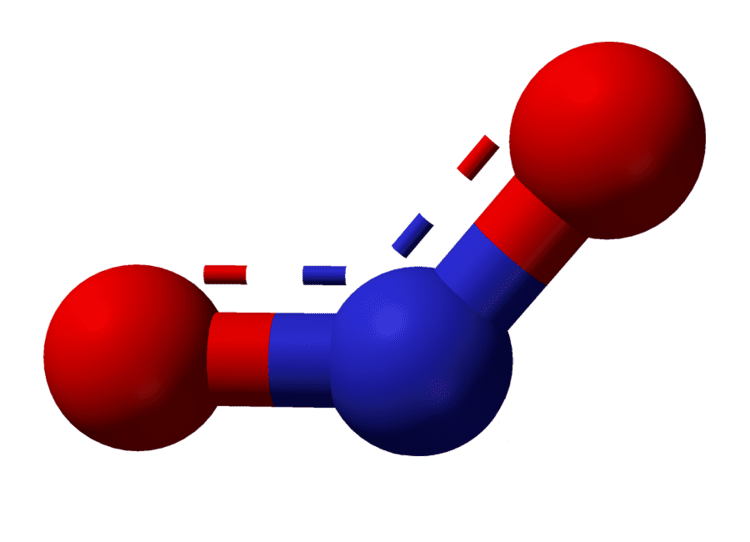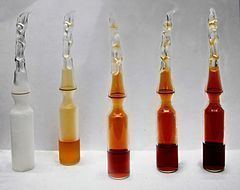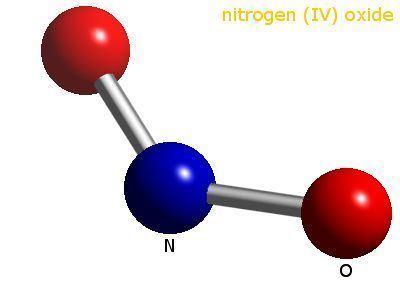Appearance Vivid orange gas Molar mass 46.0055 g/mol Boiling point 21 °C | Formula NO2 Density 1.45 g/cm³ Soluble in Water | |
 | ||
Related compounds | ||
Nitrogen dioxide is the chemical compound with the formula NO
2. It is one of several nitrogen oxides. NO
2 is an intermediate in the industrial synthesis of nitric acid, millions of tons of which are produced each year. At higher temperatures it is a reddish-brown gas that has a characteristic sharp, biting odor and is a prominent air pollutant. Nitrogen dioxide is a paramagnetic, bent molecule with C2v point group symmetry.
Contents
- Preparation properties of nitrogen dioxide
- Properties
- Preparation and reactions
- Main reactions
- Basic thermal properties
- As an oxidizer
- Hydrolysis
- Conversion to nitrates
- Conversion to nitrites
- Ecology
- Uses
- Toxicity
- Health effects of NO 2 exposure
- Avoiding NO 2 toxicity
- Environmental limits
- References

Preparation properties of nitrogen dioxide
Properties

Nitrogen dioxide is a reddish-brown gas above 70 °F (21 °C; 294 K) with a pungent, acrid odor, becomes a yellowish-brown liquid below 70 °F (21 °C; 294 K), and converts to the colorless dinitrogen tetroxide (N
2O
4) below 15 °F (−9 °C; 264 K).

The bond length between the nitrogen atom and the oxygen atom is 119.7 pm. This bond length is consistent with a bond order between one and two.

Unlike ozone, O3, the ground electronic state of nitrogen dioxide is a doublet state, since nitrogen has one unpaired electron, which decreases the alpha effect compared with nitrite and creates a weak bonding interaction with the oxygen lone pairs. The lone electron in NO
2 also means that this compound is a free radical, so the formula for nitrogen dioxide is often written as •NO
2.
Preparation and reactions
Nitrogen dioxide typically arises via the oxidation of nitric oxide by oxygen in air:
2 NO + O2 → 2 NO
2

Nitrogen dioxide is formed in most combustion processes using air as the oxidant. At elevated temperatures nitrogen combines with oxygen to form nitric oxide:
O2 + N
2 → 2 NO

In the laboratory, NO
2 can be prepared in a two-step procedure where dehydration of nitric acid produces dinitrogen pentoxide, which subsequently undergoes thermal decomposition:
3 → N
2O
5 + H
2O2 N
2O
5 → 4 NO
2 + O
2
The thermal decomposition of some metal nitrates also affords NO
2:
3)
2 → 2 PbO + 4 NO
2 + O
2
Alternatively, reduction of concentrated nitric acid by metal (such as copper).
4 HNO3 + Cu → Cu(NO
3)
2 + 2 NO
2 + 2 H
2O
Or finally by adding concentrated nitric acid over tin; hydrated tin dioxide is produced as byproduct.
4 HNO3 + Sn → H2O + H2SnO3 + 4 NO2Main reactions
NO
2 is highly reactive.
Basic thermal properties
NO
2 exists in equilibrium with the colourless gas dinitrogen tetroxide (N
2O
4):
2 ⇌ N
2O
4
The equilibrium is characterized by ΔH = −57.23 kJ/mol, which is exothermic. NO2 is favored at higher temperatures, while at lower temperatures, dinitrogen tetroxide (N2O4) predominates. Dinitrogen tetroxide (N
2O
4) can be obtained as a white solid with melting point −11.2 °C. NO2 is paramagnetic due to its unpaired electron, while N2O4 is diamagnetic.
The chemistry of nitrogen dioxide has been investigated extensively. At 150 °C, NO
2 decomposes with release of oxygen via an endothermic process (ΔH = 114 kJ/mol):
2 → 2 NO + O
2
As an oxidizer
As suggested by the weakness of the N–O bond, NO
2 is a good oxidizer. Consequently, it will combust, sometimes explosively, with many compounds, such as hydrocarbons.
Hydrolysis
It hydrolyses to give nitric acid and nitrous acid:
2 NO2/N
2O
4 + H
2O → HNO
2 + HNO
3
This reaction is one step in the Ostwald process for the industrial production of nitric acid from ammonia. Nitric acid decomposes slowly to nitrogen dioxide, which confers the characteristic yellow color of most samples of this acid:
4 HNO3 → 4 NO
2 + 2 H
2O + O
2
Conversion to nitrates
NO
2 is used to generate anhydrous metal nitrates from the oxides:
2 → M(NO
3)
2 + NO
Conversion to nitrites
Alkyl and metal iodides give the corresponding nitrites:
2 CH3I + 2 NO
2 → 2 CH
3NO
2 + I
2TiI
4 + 4 NO
2 → Ti(NO
2)
4 + 2 I
2
Ecology
NO
2 is introduced into the environment by natural causes, including entry from the stratosphere, bacterial respiration, volcanos, and lightning. These sources make NO
2 a trace gas in the atmosphere of Earth, where it plays a role in absorbing sunlight and regulating the chemistry of the troposphere, especially in determining ozone concentrations.
Uses
NO
2 is used as an intermediate in the manufacturing of nitric acid, as a nitrating agent in manufacturing of chemical explosives, as a polymerization inhibitor for acrylates, and as a flour bleaching agent. It is also used as an oxidizer in rocket fuel, for example in red fuming nitric acid; it was used in the Titan rockets, to launch Project Gemini, in the maneuvering thrusters of the Space Shuttle, and in unmanned space probes sent to various planets.
Toxicity
Gaseous NO
2 diffuses into the epithelial lining fluid (ELF) of the respiratory epithelium and dissolves, and chemically reacts with antioxidant and lipid molecules in the ELF; NO
2's health effects are caused by the reaction products or their metabolites, which are reactive nitrogen species and reactive oxygen species that can drive bronchoconstriction, inflammation, reduced immune response, and may have effects on the heart.
Acute harm due to NO
2 exposure is only likely to arise in occupational settings. Direct exposure to the skin can cause irritations and burns. Only very high concentrations of the gaseous form cause immediate distress: 10–20 ppm can cause mild irritation of the nose and throat, 25–50 ppm can cause edema leading to bronchitis or pneumonia, and levels above 100 ppm can cause death due to asphyxiation from fluid in the lungs. There are often no symptoms at the time of exposure other than transient cough, fatigue or nausea, but over hours inflammation in the lungs causes edema.
For skin or eye exposure, the affected area is flushed with saline. For inhalation, oxygen is administered, bronchodilators may be administered, and if there are signs of methemoglobinemia, a condition that arises when nitrogen-based compounds affect the hemoglobin in red blood cells, methylene blue may be administered.
It is classified as an extremely hazardous substance in the United States as defined in Section 302 of the U.S. Emergency Planning and Community Right-to-Know Act (42 U.S.C. 11002), and it is subject to strict reporting requirements by facilities which produce, store, or use it in significant quantities.
Health effects of NO 2 exposure
For the public, chronic exposure to NO
2 can cause respiratory effects including airway inflammation in healthy people and increased respiratory symptoms in people with asthma. NO
2 creates ozone which causes eye irritation and exacerbates respiratory conditions, leading to increased visits to emergency departments and hospital admissions for respiratory issues, especially asthma.
The effects of toxicity on health have been examined using questionnaires and inperson interviews in an effort to understand the relationship between (NO
2) and asthma. The influence of indoor air pollutants on health is important because the majority of people in the world spend more than 80% of their time indoors. The amount of time spent indoors depends upon on several factors including geographical region, job activities, and gender among other variables. Additionally, because home insulation is improving, this can result in greater retention of indoor air pollutants, such as (NO
2) . With respect to geographic region, the prevalence of asthma has ranged from 2 to 20% with no clear indication as to what’s driving the difference. This may be a result of the “hygiene hypothesis” or "western lifestyle” that captures the notions of homes that are well insulated and with fewer inhabitants. Another study examined the relationship between nitrogen exposure in the home and respiratory symptoms and found a statistically significant odds ratio of 2.23 (95% CI: 1.06, 4.72) among those with a medical diagnosis of asthma and gas stove exposure.
A major source of indoor exposure to (NO
2) is from the use of gas stoves for cooking or heating in homes. According to the 2000 census, over half of US households use gas stoves and indoor exposure levels of (NO
2) are, on average, at least three times higher in homes with gas stoves compared to electric stoves with the highest levels being in multifamily homes. Exposure to (NO
2) is especially harmful for children with asthma. Research has shown that children with asthma who live in homes with gas stoves have greater risk of respiratory symptoms such as wheezing, cough and chest tightness. Additionally, gas stove use was associated with reduced lung function in girls with asthma, although this association was not found in boys. Using ventilation when operating gas stoves may reduce the risk of respiratory symptoms in children with asthma.
In a cohort study with inner-city minority African American Baltimore children to determine if there was a relationship between (NO
2) and asthma for children aged 2 to 6 years old, with an existing medical diagnosis of asthma, and one asthma related visit. Families of lower socioeconomic status were more likely to have gas stoves in their homes. The study concluded that that higher levels of (NO
2) within a home were linked to a greater level of respiratory symptoms among the study population. This further exemplifies that (NO
2) toxicity is dangerous for children.
Avoiding NO 2 toxicity
While using a gas stove, it is advised to also use ventilation. Studies show that in homes with gas stoves, if ventilation is used while using gas stoves, then children have lower odds of asthma, wheezing and bronchitis as compared to children in homes that never used ventilation. If venting isn’t possible, then replacing gas stoves with electric stove could be another option. Replacing gas stoves with electric ranges could greatly reduce the exposure to indoor NO2 and improve the respiratory function of children with asthma. It is important to keep gas stoves and heaters in good repair so they are not polluting extra NO2. 2015 International Residential Code that requires that vent hoods are used for all stoves and set standards for residential buildings. This requires that all range hoods have a vent that discharges outside. You can also prevent NO2 exposure by avoiding cigarette smoking and not idling your car whenever possible.
Environmental limits
The U.S. EPA has set safety levels for environmental exposure to NO
2 at 100 ppb, averaged over one hour, and 53 ppb, averaged annually. As of February 2016, no area of the US was out of compliance with these limits and concentrations ranged between 10–20 ppb, and annual average ambient NO2 concentrations, as measured at area-wide monitors, have decreased by more than 40% since 1980.
However, NO
2 concentrations in vehicles and near roadways are appreciably higher than those measured at monitors in the current network. In fact, in-vehicle concentrations can be 2–3 times higher than measured at nearby area-wide monitors. Near-roadway (within about 50 metres (160 ft)) concentrations of NO2 have been measured to be approximately 30 to 100% higher than concentrations away from roadways. Individuals who spend time on or near major roadways can experience short-term NO2 exposures considerably higher than measured by the current network. Approximately 16% of U.S. housing units are located within 300 feet (91 m) of a major highway, railroad, or airport (approximately 48 million people). This population likely includes a higher proportion of non-white and economically-disadvantaged people. Studies show a connection between breathing elevated short-term NO2 concentrations, and increased visits to emergency departments and hospital admissions for respiratory issues, especially asthma. NO2 exposure concentrations near roadways are of particular concern for susceptible individuals, including asthmatics, children, and the elderly.
